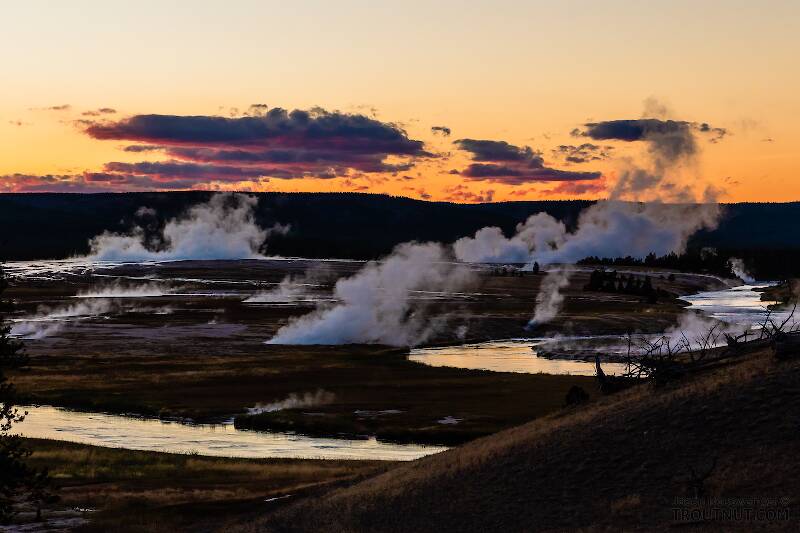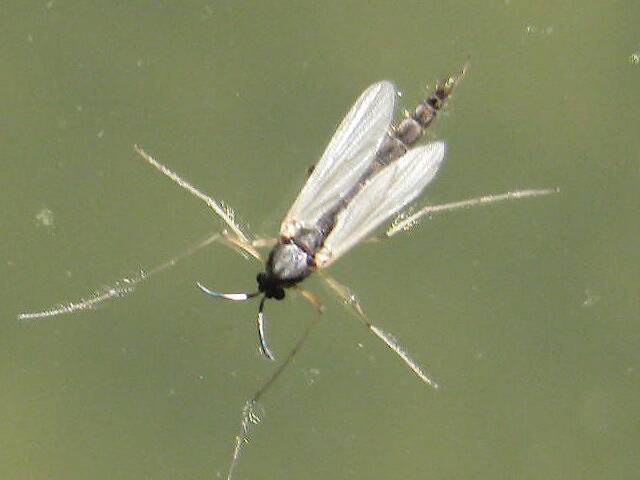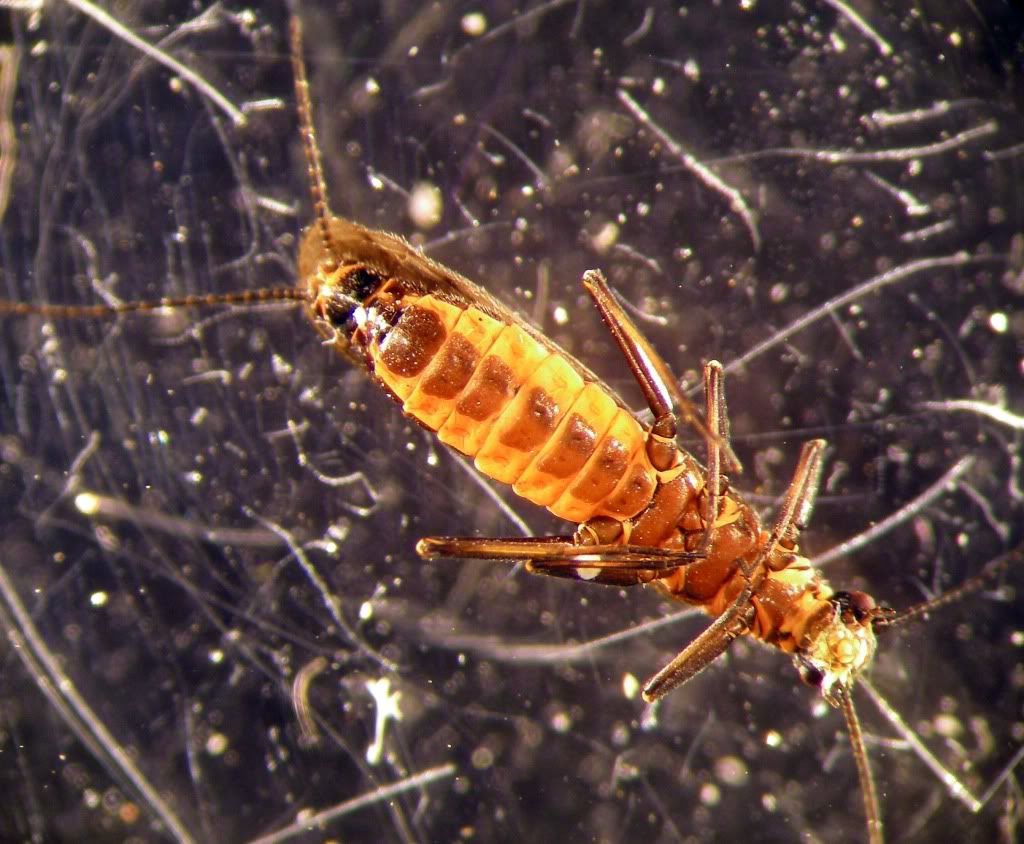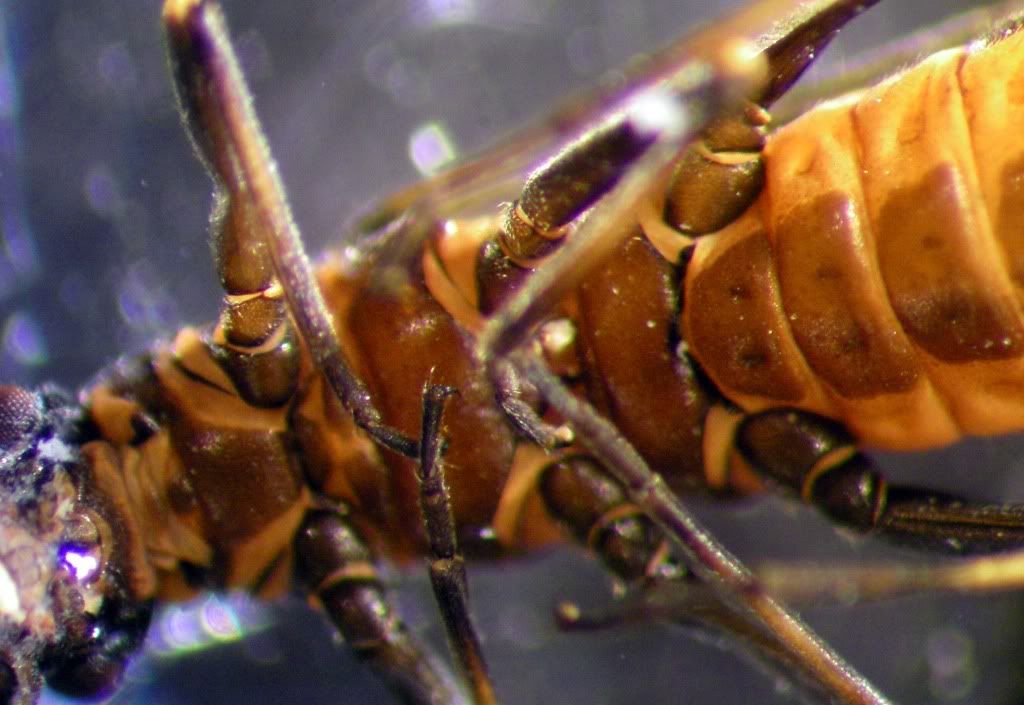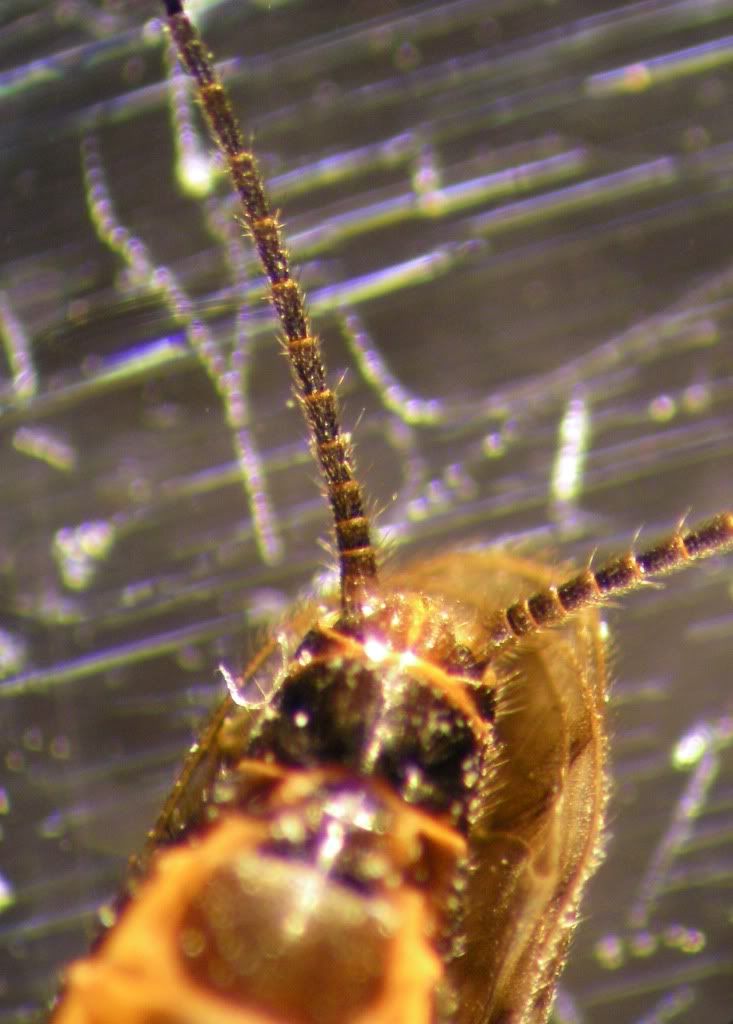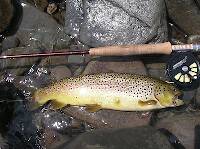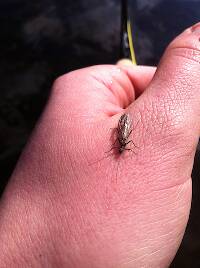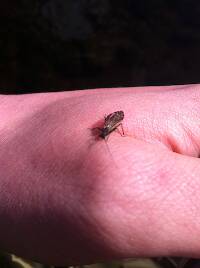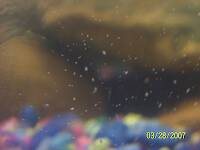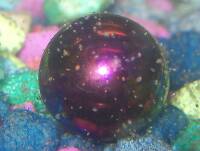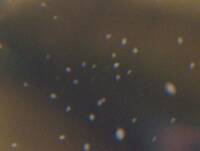
Salmonflies
Pteronarcys californica
The giant Salmonflies of the Western mountains are legendary for their proclivity to elicit consistent dry-fly action and ferocious strikes.
Featured on the forum

With a bit of help from the microscope, this specimen keys clearly and unsurprisingly to Hydropsyche.

Troutnut is a project started in 2003 by salmonid ecologist Jason "Troutnut" Neuswanger to help anglers and
fly tyers unabashedly embrace the entomological side of the sport. Learn more about Troutnut or
support the project for an enhanced experience here.
Wiflyfisher on Mar 1, 2012March 1st, 2012, 2:54 pm EST
Allen, just to clarify what I am referring too is the Early Brown Stone. I am assuming Jason's photo is from the same water all three of us frequent. I am guessing that is the hatch you are referring too.
I have had really good success fishing upstream with a size #14 cow elk hair wing and very dark blackish muskrat fur dubbing. The wing extends beyond the hook slightly and the wing is not pulled down. On some I add a couple of wraps of a soft black hen hackle before adding the wing. Nothing fancy, but it works extremely well when the stones are skittering on the surface and the trout are in a frenzy gulping them in.


BTW, the fly shop in town recommends using parachute Adams for the stonefly hatch.
I have had really good success fishing upstream with a size #14 cow elk hair wing and very dark blackish muskrat fur dubbing. The wing extends beyond the hook slightly and the wing is not pulled down. On some I add a couple of wraps of a soft black hen hackle before adding the wing. Nothing fancy, but it works extremely well when the stones are skittering on the surface and the trout are in a frenzy gulping them in.


BTW, the fly shop in town recommends using parachute Adams for the stonefly hatch.
John S.
https://WiFlyFisher.com
https://WiFlyFisher.com
Crepuscular on Mar 2, 2012March 2nd, 2012, 8:25 am EST
Falsifly on Mar 2, 2012March 2nd, 2012, 9:31 am EST
I am assuming Jason's photo is from the same water all three of us frequent. I am guessing that is the hatch you are referring too.
Yes it is. Now I have a question for you John and Eric. How long in days does this activity continue to attract the trout with such frenzy?
Falsifly
When asked what I just caught that monster on I showed him. He put on his magnifiers and said, "I can't believe they can see that."
When asked what I just caught that monster on I showed him. He put on his magnifiers and said, "I can't believe they can see that."
Crepuscular on Mar 2, 2012March 2nd, 2012, 9:45 am EST
Well in my experience on the streams of south central PA as long as the water is as close to 50 degrees as possible (or warmer) these flies become worth the trout's energy. They are just now really getting going on the smaller trout waters, and it will stay that way until the end of March. I have also seen in the last two weeks a smattering of Baetids as well with fish eating them occasionally too. But That being said I started seeing these flies about two weeks earlier than most years this winter. I actually saw a couple caddis on the Yellow Breeches on Tuesday. So I suspect we will start to see the grannoms here shortly soon to be followed by the Hendricksons.
Entoman on Mar 3, 2012March 3rd, 2012, 12:06 pm EST
John -
Good. While everybody else is flogging away with the ubiquitous Parachute Adams, you'll have the edge with your more precise imitations.:)
Erik -
Regarding your flies... I like! Especially when compared to John's photo of the flutterer.
BTW, the fly shop in town recommends using parachute Adams for the stonefly hatch.
Good. While everybody else is flogging away with the ubiquitous Parachute Adams, you'll have the edge with your more precise imitations.:)
Erik -
Regarding your flies... I like! Especially when compared to John's photo of the flutterer.
"It's not that I find fishing so important, it's just that I find all other endeavors of Man equally unimportant... And not nearly as much fun!" Robert Traver, Anatomy of a Fisherman
Wiflyfisher on Mar 3, 2012March 3rd, 2012, 12:35 pm EST
Yes it is. Now I have a question for you John and Eric. How long in days does this activity continue to attract the trout with such frenzy?
Dunno. I have never had that amount of time on the water during the early C&R season.
I will say, these little guys seem wired too me, especially when you consider the air temps aren't that warm. They are full of energy and don't seem to want to sit still.
Let me know how you do.
John S.
https://WiFlyFisher.com
https://WiFlyFisher.com
Crepuscular on Mar 6, 2012March 6th, 2012, 10:43 am EST
Entoman on Mar 6, 2012March 6th, 2012, 9:03 pm EST
Great run of pictures Eric! It is so nice to work with photos that show what is needed to make a determination. The Tails, A2 vein, and tarsal segments are clearly Capniidae. I also agree with you that this is Allocapnia (Little Snowfly). The separated postfurcal plates (those little round dark areas on the mesosternum) distinguish it from the only other genus in PA. This is a female for reasons besides close proximity to an egg packet.
Figuring out the species is where it gets really interesting. In PA there are currently 15 species reported. The good news is the configuration of the ventral terminal segments clearly eliminate all but a few. Also, the R and M vein branchings and crossveins in the wings are much closer to the apex than is seen in most species. Based on these characters, my first impression was this was probably A. granulata. Ernest Schwiebert mentioned them as being important Winter fauna on the Brodhead and they are reported to be the most numerous. However upon comparison with the descriptions provided in The Classification, Evolution, and Dispersal of the Winter Stonefly Genus Allocapnia, Ross & Ricker (1971), the terminal segments don't line up well and the wings are too long. Your specimen is a much better match with one of the forbesi group, probably A. curiosa
BTW - adding a big yellow ball of dubbing at the tail on some of your imitations might be a trigger.. It'd be worth a try, anyway!
Figuring out the species is where it gets really interesting. In PA there are currently 15 species reported. The good news is the configuration of the ventral terminal segments clearly eliminate all but a few. Also, the R and M vein branchings and crossveins in the wings are much closer to the apex than is seen in most species. Based on these characters, my first impression was this was probably A. granulata. Ernest Schwiebert mentioned them as being important Winter fauna on the Brodhead and they are reported to be the most numerous. However upon comparison with the descriptions provided in The Classification, Evolution, and Dispersal of the Winter Stonefly Genus Allocapnia, Ross & Ricker (1971), the terminal segments don't line up well and the wings are too long. Your specimen is a much better match with one of the forbesi group, probably A. curiosa
BTW - adding a big yellow ball of dubbing at the tail on some of your imitations might be a trigger.. It'd be worth a try, anyway!
"It's not that I find fishing so important, it's just that I find all other endeavors of Man equally unimportant... And not nearly as much fun!" Robert Traver, Anatomy of a Fisherman
Crepuscular on Mar 7, 2012March 7th, 2012, 4:51 am EST
Well after tearing my office apart yesterday and not being able to fine my Ross & Ricker (1971), I must have loaned it to someone, I didn't venture any farther than Allocapnia, but in a recent paper from Jane Earle: New State Stonefly (Plecoptera) Records for Pennsylvania, with Additional Records and Information on Rare Species (2009),http://www2.pms-lj.si/illiesia/papers/Illiesia05-16.pdf, she mentions A. aurora collected from the same place that these little ladies were collected. But aurora is not in the forbsei group is it, I think it's in the pygmaea group. Since I am so absent minded and cannot for the life of me remember what I did with my Ross & Ricker I was not able to do anything else with these.
Entoman on Mar 7, 2012March 7th, 2012, 1:28 pm EST
Eric -
It is in the pigmaea group. Good memory! The chief difference between the more common pigmaea and aurora is the latter can stand a little warmer water. The two are very similar in appearance (tiny, black). Besides size & color, both have completely different genitalia and 7 - 10 sternites than your specimen. The wing venation in the pigmaea group is also much simpler.
But aurora is not in the forbsei group is it, I think it's in the pygmaea group.
It is in the pigmaea group. Good memory! The chief difference between the more common pigmaea and aurora is the latter can stand a little warmer water. The two are very similar in appearance (tiny, black). Besides size & color, both have completely different genitalia and 7 - 10 sternites than your specimen. The wing venation in the pigmaea group is also much simpler.
"It's not that I find fishing so important, it's just that I find all other endeavors of Man equally unimportant... And not nearly as much fun!" Robert Traver, Anatomy of a Fisherman
Crepuscular on Mar 7, 2012March 7th, 2012, 5:40 pm EST
Kurt, don't be too impressed I just have been re reading a lot of material in the last few days I'll forget it all in a short period of time. And then I'll read all again next February...
Entoman on Mar 7, 2012March 7th, 2012, 5:53 pm EST
Ha, me too Eric.:) That's one of the reasons my comments are often pretty detailed (probably to the immense boredom of many Troutnutters). I need to have it written down so I can remember what I said & why, from even last week!:)
"It's not that I find fishing so important, it's just that I find all other endeavors of Man equally unimportant... And not nearly as much fun!" Robert Traver, Anatomy of a Fisherman
Quick Reply
Related Discussions
Topic
Replies
Last Reply

